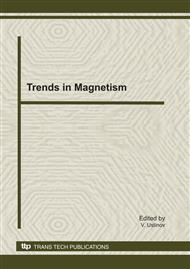p.307
p.313
p.317
p.321
p.325
p.329
p.333
p.341
p.345
Magnetic States of Nanodot Arrays. Physical and Numerical Experiments
Abstract:
The research method for the investigation of magnetic states of single nanoparticles, 1D arrays, 2D, and quasi-2D arrays is used. The possibility of the nanodots magnetic states reconstruction by the space distribution of gradient dipole-dipole interaction force is theoretically justified. The comparison is made between the results of nanoarchitecture numerical simulation in an external magnetic field and experimental data.
Info:
Periodical:
Pages:
325-328
Citation:
Online since:
December 2010
Authors:
Price:
Сopyright:
© 2011 Trans Tech Publications Ltd. All Rights Reserved
Share:
Citation:


